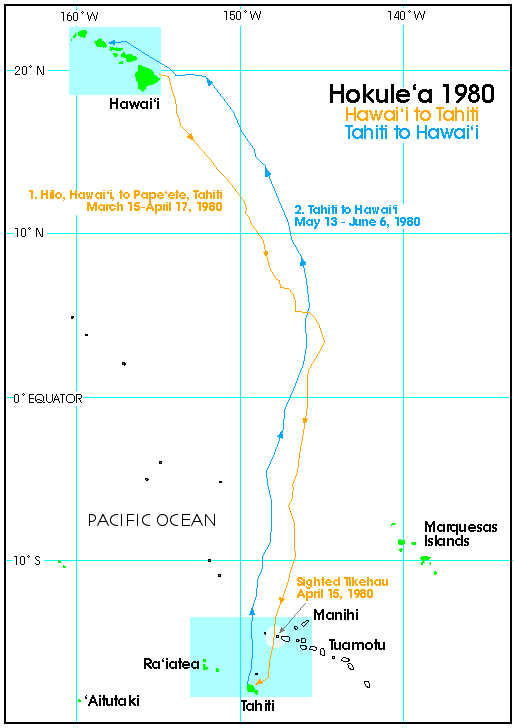The Wayfinder: 1980 Voyage Home
Nainoa Thompson
[This account of the 1980 return voyage from Hawai'i to Tahiti is a chapter from Will Kyselka's Ocean in Mind. Will explains the genesis of the writing: "The words are Nainoa's, the form is mine. The words come from tape recordings, talk-story times, and a paper he submitted in English 101 at the University of Hawai'i. Much of the original is reflective--Nainoa recalling, remembering, relating, piecing together thinking in retrospect what the experience must have been at the time. To preserve the immediacy of events, I've put it all into present tense."
Hokule'a left Pape'ete, Tahiti, on May 13, 1980 and sighted Mauna Kea on the Big Island of Hawai'i 22 days later, on June 4, 1980.]
Introduction
It seems to me that the way I shivered at night in the cold aboard Hokule'a in the storm after we left Hilo was the same as when I was young and diving at night along the reef. The wind and the ocean supply the cold, and I understand nature through exposure to it. I cannot really convey the feeling within me of that wind any more than I can tell you what it is like being the navigator. Yet that is my task in this chapter.
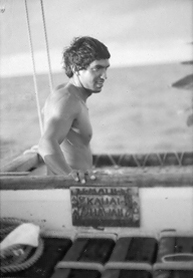
Nainoa. Photo by Mike Tongg
May 13, 1980
Sunrise on the cliffs of Matavai Bay at Point Venus. Each morning for five days we've been watching for the wind. But, just as on our departure from Hawai'i, the wind has not yet been ready to grace the sails and allow Hokule'a to glide along sea roads traveled by explorers of old. We've been waiting for a straight wind, a wind to depart on. Today we have that wind. It's not an ideal wind but it is one that we'll depart on.
The canoe is ready for the sea. A new boom replaces the one we broke on the trip down. Stress had also caused the laminations on the crossbeams to begin separating. Metal plates were bolted to them to strengthen them for the return trip.
It's late afternoon when we depart Tahiti. A ceremony once again affirms the bond between Polynesian peoples and sends us on our way. The setting sun is casting its last rays on high clouds as we leave Tahiti behind in SW Na Leo. Soon the first stars appear and the heavens demand our attention. Thoughts of the hospitality of our Tahitian friends and family are put away and we are left with only ourselves and our memories.
The Southern Cross is now high in the sky behind us. Each night for the next three or four weeks we'll see it slightly lower, and by the time we reach Hawai'i it will be at the horizon. It will be ten days yet before we'll see the North Star. During the next few hours the tiny island of Teti'aroa will be moving along our star compass from 'Akau to Hema as we pass close to it.
The first dawning of light is the important time for the navigator. It is the time for judging the sea and swells relative to the positions of the stars, a time for the reading of the weather for the day. Light creates the day and the colors in the clouds and in the mists in the salt air. Mau has internalized countless sunrises, so he knows how to read the weather and when it is right to sail. For him this knowledge is the means of survival of his island's people. For us this canoe is our way of understanding the people of old.
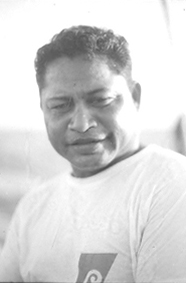
Mau. Photo by Mike Tongg
Navigating without instruments is a personal act. You must know the principles but you cannot reduce wayfinding to a set of formal operations. I'm constantly discovering new things that are useful in getting the canoe there.
On this trip I've been getting glimpses of a greater world of navigation, far beyond what I prepared myself for. I learn through my culture, but that alone is not enough: it does not provide all the right answers. When I understand things without knowing how, that's when I know I've taken great steps.
Like knowing where the moon is: One night it was really cloudy. It was nearly a Full Moon but clouds were so thick you couldn't see it. Still I knew where it was even though there was no reason for me to know. I could have figured it out analytically, but I already knew. Here's a separation between knowledge and understanding. At times like that I know, but I don't know how I know.
Sleep is not a problem. I thought it might be but it isn't. When you accept responsibility internally you don't need all that much sleep. In a way you've got no choice. You make the decision to be here, and once you're here you're accountable.
Mau says he never sleeps when he's navigating. He says his eyes are closed but inside he's not. Somehow he rests enough to take care of the fatigue and he maintains his orientation. It's fascinating, this man's abilities.
My job is getting the canoe there, not to find out what ancient people did. That understanding comes as a result of a task gladly accepted. This is a unique situation-being responsible for giving direction and getting the canoe there without ever having done it before. It's full of unknowns.
There's a world out here that I didn't know anything about until forced into it by my choices. Analytic thinking alone cannot bring understanding, and I'm glad of that. We aren't searching for understanding, but understanding is coming as a result of the search.
In a sense there were no choices once we got into certain situations. That won't be reflected in the transcripts because at the time it happens I cannot express how I know. I don't understand at the time,.and I still cannot express it. The transcripts are pictures of the struggle I feel at a particular moment.
June 1, 1980

Dawn. The first rays of dawn hurt my eyes after straining all night to maintain the sailing course. I have an uneasy feeling this morning, for I know that the thin sheet-like layer of cirrus cloud that moved in last night can mean a change in the weather-a change from the regular trades-and that can make navigating difficult. It was difficult last night, at times impossible, even to identify the stars that did show through the breaks. This morning the cloud is too high and too thin to cause shadows, but it makes the sea look more gray than blue.
The soreness in my eyes at dawn comes from the strain and fatigue of keeping Hokule'a on course. Most of the night we steered by the moon.
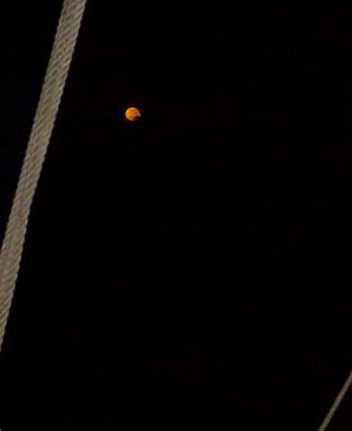
It is now two days past Full Moon phase, the night of the month that Hawaiians call La'au Ku Kahi. Fortunately for us it was a big moon, nearly opposite the sun, and its light was with us most of the night. When it is nearly round and close to the horizon we use it for steering.
The sun rose this morning in the house of 'Aina on the star compass. It is most reassuring (and a compliment to the crew) to find both the canoe and the rising sun in their correct positions. For myself and the crew who had the steering duty for the last four hours, relaxation is now in order as the sun comes up.
With the sun on the horizon we have a solid steering sign. It's in the house of 'Aina, so we can assume that we sailed a most accurate course during the starless night. I feel the urge to give in to my fatigue, but it is not yet time to sleep.
The steering swells in line with the sun are clearer and more defined than they were yesterday. Each day since we left the doldrums the swells have been getting more and more defined, sorting themselves out in the dominant trade winds.

Daylight hours. I cannot relax on this first day of June. Because of the persistent high cloudiness, we have not seen stars very much in the last ten days. We're going 6.5 knots, but I do not have the vital information needed on our position change. I cannot relax. That's the hardest part for me, both mentally and physically. The conflict in mind and body brings tenseness and fatigue at a time I most need to be alert.
I estimate that we have traveled 260 miles without positioning ourselves by the stars. That's an empty feeling as we approach the target of the Hawaiian Islands.
We steer most of the day off the wind. Since morning the wind has shifted to east northeast, a change that brings a familiar coolness that reminds me of the normal trade winds of Hawai'i. I have pondered many times the familiarity of new experiences during the voyage, as if somehow I have had such experiences before. In understanding the blending of my ocean past as a youth with the discipline of sailing lies the most cherished parts of myself.
When the wind swings northeast as it did today, it confuses the swells that we steer by. They lag behind the changing wind direction. For myself, such unsorted swells and waves also leave me confused.
Today we're using the high cloudiness that blocked the stars the last two nights. It's a special circumstance that allows us to use the clouds-very high clouds, moving slowly, very far away. Under these conditions the apparent motion of the canoe will have little effect on the bearing of these nearly stationary clouds.

Sunset. The June sun sets in the house of 'Aina, two houses north of due west. High clouds in the west around the sun take on a deep red color. The evening is dark, for it is three days beyond Full Moon, and tonight it will rise about three hours after sunset. John Kruse is at the steering sweep, keeping the direction of Na Leo as we sail from day into night.
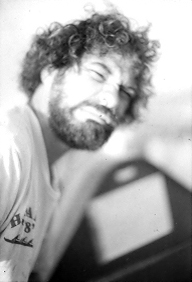
John Kruse. Photo by Mike Tongg
The true wind is right on our beam, and the canoe is quite dry as we race away from the crests of ocean swells.
The air is getting cooler as we increase our distance from the equator. How important the yellow foul-weather gear is to me when I contemplate another night of exposure to wind and waves and rain through ten hours of darkness! So many the reasons to admire the first Polynesian voyagers who sailed without such gear. How natural to be proud of my heritage.
We search the sky this evening for those stars that target the land, but the ocean horizon is clouded over. I have a very unsettled feeling. When we're nearing land we need the stars most-but now they're not there. Instead of getting clues from my eyesight, I'm left to my imagination, and I think of drops of water 10 miles distant blocking the light that has been traveling for 40 years to reach us.
Our course made good all day is between Haka and Na Leo. I estimate that we've traveled 72 miles and that we're 13.50 north of the equator, 7.5 houses west of the course line. I believe the islands of Hawai'i to be in the direction of Manu, 550 miles northwest. In the back of my mind, though, I'm bothered by our yesterday's sighting of the manu ku [white tern]. How can this land bird be so far from land? How can it have flown so far if I'm to believe that it is away from its home island only between dawn and dusk?
June 2, 1980
Dawn. Since sunset last night I estimate we sailed 60 to 70 miles north northwest. A few stars of the land showed in the middle of the night through gaps in the cloudy sky indicating that we are 140 north of the equator.
The eastern horizon is showing a lot of red as sunrise approaches. High cirrus clouds are still present, with cumulus clouds at low levels showing the surface trade winds. Bruce takes command of the steering sweep as we enter the most critical phase of the voyage- targeting the Hawaiian Islands. We have very little room for error.
The sun is replacing night with day. The bearings of the swells are somewhat confusing, apparently because of the changing direction of the wind. Whether it is that way in the sea or just in my mind, I am not sure. I've had little sleep in the last few days. Concentrating is a chore. This is the first time on the voyage, either down or up, that I'm feeling a little sick-a chest cold. Maybe it is anxiety, wondering if we have been accurate with our course. Are the Hawaiian Islands in the direction of northwest 'Aina? Uncertainty occupies my mind. But when forced to make a decision, I know that I have only mind and memory-and faith in myself. Without that I'm lost.
We're doing 6 knots off the wind. Steering is difficult. Hokule'a is constantly trying to round itself to the windward in an attempt to parallel its hulls with the dominant swells. It takes skill and ability to anticipate the effect of the oncoming swells. Fully loaded, Hokule'a weighs nearly 10 tons, and that's a lot of weight to control. Once a steersman loses control to the swells there is very little that can be done. Experience is the steersman's greatest teacher.
Daylight. The high clouds disappear and leave the trade wind cumulus, a very good clue to steady trade winds. We have a light lunch, and the crew spends most of the day steering and trimming the sails. Bruce, who is the primary fisherman on this voyage, is constantly tending to the fishing lines.

Bruce Blankenfeld. Photo by Mike Tongg
This leg we have been running larger lures than we have run in the past. Even though we have not caught as many fish as we did on the other voyages, those we have hooked have been comparatively big ones. We picked up one nearly 100-pound marlin, a 50-pound sailfish, and a 30-pound mahimahi. We also lost at the gaff an 'ahi that I estimated to be 60 pounds. We had our slim share of small aku, kawakawa.
Our diet aboard Hokule'a is basically canned, packaged, and dried food. All our fresh provisions were eaten, or they were tossed overboard because of spoilage. Last to go were the citrus fruits. A frequent topic of conversation, as we get closer to land, is that of the first things we will eat when we arrive home.
Snake Ah Hee has become our official cook-unofficially.

Snake Ah Hee. Photo by Mike Tongg
Right from the start of the trip he has taken over in the kitchen. I am certain at times I have seen him fighting over the right to the pots and pans in the galley. Good meals can at times be one of the few things to look forward to at sea, and cooking is not easy at sea on Hokule'a.
As the sun nears its setting place on the horizon the canoe is being cleaned. Some of the crew are washing themselves with a salt water bath. Others are putting on their foul-weather gear, preparing for another night at sea. Nathan Wong is steering.
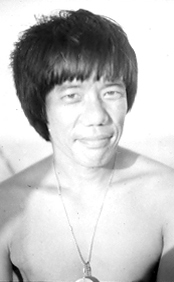
Nate Wong. Photo by Mike Tongg
Nate sails in the dual role of crew member and physician. Medically we are all healthy and sound. We're grateful for that. We've had, our share of minor sunburns and rashes, along with Kainoa Lee's bad cold. It is comforting to have Nate on board in case of a serious problem.
No land birds today. Their absence stirs doubts in my mind. But if my estimate of where we are is correct, we must still be out of the flight range of land birds anyway. It's their absence that makes me uneasy.
Sunset. As the sun sets in the west northwest, I estimate the island of Hawai'i to be two houses to the right in the direction of northwest Manu, 360 miles away.
We've traveled, as I estimate it, 72 miles since sunrise in the direction of Na Leo. Winds are 18 knots out of the east northeast as we're sailing 6 knots abeam to the true wind. The wind and swells are steady and straight. With the sky clear of high clouds, it appears we will have good weather at the time we need it most. I feel good about that.
Wedemeyer Au steers Hokule'a in the direction of the setting sun. In the fading glow of twilight he uses the light of the brighter, very distant stars to guide him as we sail ever toward Hawai'i, our homeland.

Wedemeyer Au. Photo by Mike Tongg
The Southern Cross is nearing the southern horizon. Our timing for landfall is critical in that certain groups of stars must be in the right position relative to the sun. The Southern Cross is the most important of the constellations for us now. It is getting toward the west and will be available in its useful position for only a week or ten days more.
As I watch the Southern Cross, so does Mau. He has kept himself uninvolved with the navigation and sailing of Hokule'a Navigation takes constant memorization of our course made good. For the most part Mau has divorced himself from that effort; yet as the stars of Hawai'i begin to show in the twilight, anyone with that knowledge cannot help but be concerned about the accuracy of the course we have kept. Are we truly to the east and upwind of Hawai'i?
Steering is easy on this cloudless night, but in the early morning hours I tend to become tired. The more I force myself to stay awake, the more fatigued and less alert I become. I need rest to clear my mind.
We are nearing our destination. Mau scans his ocean heaven for important stars. It is as if I know what he is feeling. I know because of what I have gone through on this voyage. My thoughts are sad as I realize the wealth that he has given me, in sharing navigational secrets in the context of the tradition of his culture. My thoughts are sad that the voyage will soon end and with it his teachings, for he must go back home to Satawal. He is a man of priceless gifts. A man who took our hands, as if we were children, and walked us through it all upon the wake of our ancestors. As I watch him look at the land stars he knows so well, I cannot help but feel sad.
I begin this night full of anticipation, and at the same time I'm very tired. Through this experience I'm beginning to understand the suffering of Mau in maintaining his heritage, a difficult task in a rapidly changing world. I don't know the depth of the hurt he feels in seeing more of his culture lost with each generation.
Night passes with only a partial cloud cover. Stars make their paths across the sky. We're able to use the land stars of the Southern Cross (Hawaiians also know it as Newa), Atria in the Southern Triangle, and the two brilliant stars, Alpha and Beta Centauri. Hokupa'a, the North Star, is gaining altitude each night, and from this array of stars I judge South Point to be 180 miles to the north and 220 miles west of us.
June 3, 1980
Sunrise. Early morning brings a freshening wind of 22 knots from east northeast. I'm cold after another full night of being on the open deck of Hokule'a. The two bright stars in Aries, Sharatan and Hamal, are rising. At this time of year their appearance on the horizon brings the first light of dawn-a good sign for Snake's watch, which has been on since two this morning. Since we have no time-pieces aboard, our simple routines are kept by the light of the stars and sun. The brilliant red and purple colors of these beautiful clouds of dawn, though, may be a sign of bad weather.
Kainoa Lee is steering as the sun breaks the ocean horizon, on this our 21st day at sea.
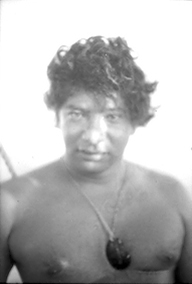
Kainoa Lee. Photo by Mike Tongg
The sun's orange rays are guiding him on his course, northwest Na Leo. With the increased wind speed we are traveling at 8 knots toward the Big Island in the direction of Noio. If we maintain our course and speed, the island should be in 'Aina tonight, not much more than 210 miles away. I feel very uneasy about such estimates: what if we sail more than 200 miles from here and find no land?
Cloud cover is 40 percent, not a comforting thought now that we are so close to land.
I am awakened by loud conversation. I see the sun still near the eastern horizon, and I realize that I have slept only a short while. My mind and body agree. Off the left side of the canoe is a group of white birds. As far as I can tell they're mostly the white tropic bird, koa'e kea. But within the group is at least one manu ku, the bird that indicates land. The ocean is filled with white caps, so white birds flying low are hard to see. We watch as long as we can see them. Apparently they're fishing, not flying to or from land. Nevertheless, it puts me more at ease in my upcoming sleep to know that we're in the circle of manu ku and near Hawai'i.
It's clear to all of us that land is near. We set a watch to keep a sharp lookout for any sign of it. I still feel that we are south and somewhat east of our target, so we hold a course between northwest Na Leo and Nalani. We do not want to sail to the west of the Big Island, so we'll hold that course until we can get a good star clue tonight.
This day seems to pass slower than any other day. We're still straining to see the land. The optimism in seeing land birds in the morning is being tested by the length of the day. In the minds of us all lies the shape of the land.
I was sitting on the aft navigator's platform this afternoon and Steve was sleeping on the forward platform. Suddenly I saw a brown boobie floating on the water about 70 feet off the starboard bow. Just at the moment we were sailing past the resting bird, Steve woke up. He saw it, jumped up and shouted, "Ring-necked mallard! Ring-necked mallard!" I was astonished with his enthusiasm and with that misidentification. I looked at him as he seemed to turn to me to see if he had any reason to think he was correct.
Maybe it was fatigue or merely the absurdity of the situation; anyway I did not even feel the need to react. I just continued studying the ocean as Hokule'a sailed past the boobie. Steve straightened himself and collected his wits as if nothing had happened. Had he been right, this "ringed-necked mallard" definitely would have been off-course and in deep trouble. But I guess birds of the land occupy even the dreams of those who sail in search of new islands.
Sunset. We use the last moments of the day to look for birds and any other clues to land.
During the night high clouds move in from the southwest, and on the southern horizon we see the first signs of a build-up of rain squalls-both signs of changing weather. Today was the first day in six that we were able to enjoy relatively clear skies, yet that clarity is now being threatened.
East-northeast winds have heightened to 18 knots. This morning I estimated our distance from land as 210 miles. But almost as if I need to cushion myself from the increasing doubt that is building up in me, just for no reason I changed the distance to the Big Island to 300 miles. Due to my inexperience or immaturity (or both), I changed my thinking to allow the Big Island to be that far away. A cushion allows for human error and gives us a reason not to panic if we do not see the islands by tomorrow morning.
Rain comes in the early evening twilight. Crew members, now used to the ways of the sea, already have on their foul-weather gear. The clouds are moving with extreme uniformity-distinct cloud streets with rows of cumulus nimbus clouds paralleling each other, equally spaced, and all of the same altitude. Soon the rows of clouds encompass the world of the canoe. As we sail abeam to the wind and rain, we pass from rows of rain to rows of clear sky and on into the night of our 21st day at sea.
Only the stars overhead are visible between the rows of rain. Stars for the land may not show themselves if the rain should stay all night. But let's not think of such things so early in the night with land so close.
As I search for the land in the direction of a particular group of stars, all I see are those rows of rain clouds that we just passed through. But to the east of south I see a break in the clouds, a gap traveling at a speed different from the prevailing trades. I watch and hope it will not change form or continuity, so not to allow the gap to give a clear vision of the stars I seek. As I watch I know the night is very early, and that such stars will be in their correct positions for the land I desire.
The gap in the clouds moves closer to the south. First to appear are the faint stars to the east of what I seek. Moments later, with anticipation, the land stars show themselves in the positions I need them to be. I stare till I'm sure. Now I know by our latitude and dead reckoning that we are close. I turn to my right to see Mau and Mike Tongg staring at the same thing. Nothing is said, for nature has told us all that we need to know.
Most of the night passes with rain. Not until early morning do I see the North Star. The rain makes the sky more clear. Just before the rising moon is Maui's Fishhook (Scorpius) appearing through a break in the clouds. What a magnificent sight, the barb of the Fishhook in the direction of the center of the Milky Way! High above these clouds and at the top of Mauna Kea, astronomers may right now have telescopes aimed toward that galactic center. A few months ago I was up there in that cold, studying the stars. Thoughts of the old and new blend in my mind.
Anticipation plays tricks with my mind and senses. Not knowing if it's imaginary or real, I struggle with visions of towering mountains appearing above dark rain clouds, much like a child who believes clouds are what things are made of. Continuously I question whether I can feel unusual swell patterns that might be backwash off the Hamakua coast. Is that the sound of surf crashing on the cliffs? Rain and cloud are blocking our vision. Such thoughts running through my mind are not based on logic but rather imagination kindled by hope. However, it turns out to be a night only of images that leaves me exhausted. For my own sake I will need to relax. The land will show itself when it will. I must give up and give in to the notion that I can do nothing about it.
June 4, 1980 Landfall
The first streaks of light on this morning reveal gray and black clouds at both low and high levels. During the night I saw the Southern Cross near the horizon and I know Hawai'i is near. My experience in seeing Crux from places in Kaua'i, Maui, Kona, and South Point tells me that the canoe is in the latitude of Hawai'i. The time for changing our course from a general northwest direction to a more westerly one is near.
Long rows of low clouds show straight winds coming from NE 'Aina. Hokule'a is heading NW Na Leo, crosswise to the wind. The rising sun breaks that long dark line into individual puffs of cloud, orange in color. High clouds are becoming more scattered now, showing as thin streaks of red against a background of light blue sky. Straight winds and clearing skies are a welcome sight after the last three days of rain.
A couple of hours before noon we see a thin, gray line beyond a bank of clouds almost dead ahead. With the sun high in the sky and somewhat behind us yet, and with rain clouds lifting, the line seems stationary. It is not particularly distinct. What is it?
We have a meeting of the crew to work out a strategy. We will make two tacks, one at noon and another at sunset. We hope that by holding a course as close as possible downwind we will be able to see for sure if the line that we think we see is an island or not.
Our new tack puts us on a course of SW 'Aina; then I go to sleep for about two hours. When I awake in mid-afternoon, I find we're looking right into the glare of the sun reflecting on the water making the sighting of land in that direction impossible. It also makes it hard to judge the movement of clouds, an important clue in finding land. Clouds over the sea move, but those around the mountains are stationary.
Also steering SW 'Aina after three weeks in NW Na Leo makes the land move differently along the compass. Now the land is moving northward at a speed dependent upon our overall direction and speed during the time I was asleep.
With these two conditions I feel a lack of confidence as to where the line I thought I had seen in the morning really was. Maybe that line had been only in my imagination. We're at the right latitude for Mauna Kea, and now only one question remains: does it lie downwind or upwind, to the west or to the east?
We saw no birds this morning, no sign of manu ku. Seeing no birds at all makes the direction of land even more uncertain. Have I been too hasty in turning west to find the land? Could it still lie to the north and my memorizing system be inaccurate? Worst of all, could it be that we are too far to the west, downwind of our destination?
We try steering in the direction of that line we had seen by pointing the canoe almost straight downwind, SW 'Aina. We have a straight wind from NE 'Aina and a dominant Hikina swell. Even then, we cannot hold the course. Steering is just too difficult.
I keep straining to see something like images of mountains or clouds that don't move. It's hard to see anything in the glare of this hot afternoon sun. Straining makes me sleepy. I know that. I also know that I'm likely only to be fooling myself. I must be patient and let the mountain show when it is ready.
The plan we had worked out in the morning was to change our tack after dinner so we would not get too far south. Instead, we begin tacking at about 5 P.M. Our new heading is NW 'Aina, close to the direction of the setting sun. We see no birds at all, making it all the more difficult to know where we are relative to the island of Hawai'i.
The sun is nearing the horizon and a peculiar image is forming. I don't know why. The cloud bank turns a dark gray, almost black, like rain. Around the cloud bank, though, is a consistent orange color. It's a strange sight.
Something is different about that setting sun. It's something we haven't seen before. So we alter our course slightly and head directly into the sun, NW 'Aina.
The crew is silent. I think they have a feeling, too, that land lies just below the sun. It is as if we're all standing on tip-toes waiting, and a feeling comes over me that this is the way things are supposed to be.
I remember a story I was told one time (how accurate I do not know) of the people of ancient Polynesia. They had their family guardians, ku'ula, that gave them prosperity. They were symbolized as figures shaped of carved stone. Fishing families had their ku'ula that attracted fish and gave them protection. The navigator of old, as the story goes, was not like other men. He was separated from them-a man of the sea, not of the land. So his ku'ula was not bound to the land but was the land itself-the highest mountain, a mountain of power.
I stand on the bow of Hokule'a watching the sun dropping toward that cloud bank and I question how much control, if any, I have in finding the land. This is the way things are supposed to be.
Closer and closer it comes to the cloud, and I have a different, almost strange feeling. The sun is right in the compass direction of ‘aina (land). It is pointing out the land.
I walk to the bow of the canoe for I know the island is there. I don't know how I know. Steve Somsen also knows. Not that he really knows, but he's picked up on my knowing it's there.
Suddenly a particular cloud begins separating. It has the same quality as other clouds in terms of whiteness. But this one is not traveling. It's stationary, and it opens up to reveal a long, gentle slope with a slight bump-a cinder cone on the side of Mauna Kea!
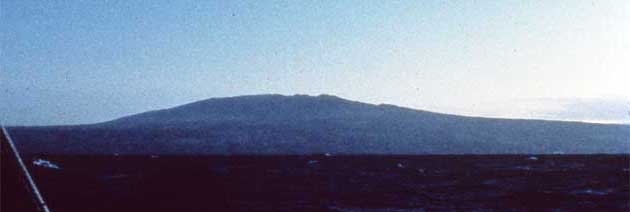
The navigation at this moment seems to be out of my hands and beyond my control. I'm the one given the opportunity of feeling the emotion of the navigator not yet ready to have a complete understanding of what is happening. It is a moment of self-perspective, of one person in a vast ocean given an opportunity of looking through a window into my heritage.
I hear the crew cheering as the edge of the sun begins disappearing behind Mauna Kea. I feel their happiness, but a silence in me sets in. Venus follows the sun and touches the mountain an hour later.
It is now time to sleep, for there is nothing else to do. The sun has led us to the land. Ahead of us is our ku'ula, and I'm filled with a feeling of emptiness and gratitude.
But before I sleep I check on Mau. He's already asleep--something unusual for him at this time of night.
Crew Members, Tahiti-Hawai‘i: Nainoa Thompson-Navigator, Snake Ah Hee, Wedemeyer Au, Chad Baybayan, Bruce Blankenfeld, John Kruse, Kainoa Lee, Kimo Lyman, Gordon Pi`ianai`a, Mau Piailug, Steve Somsen, Leon Sterling, Michael Tongg, Nathan Wong.
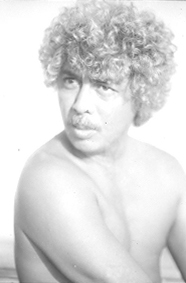

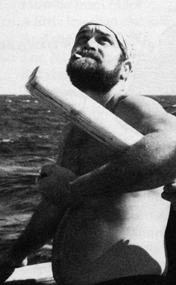
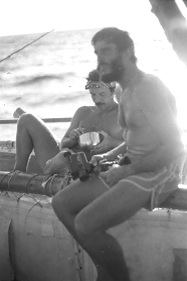
Clockwise from top left: Gordon Pi‘ianai‘a, Kimo Lyman, Steve Somsen, Leon Sterling. Missing from KS Archives photo sheets: photographer Michael Tongg (below).
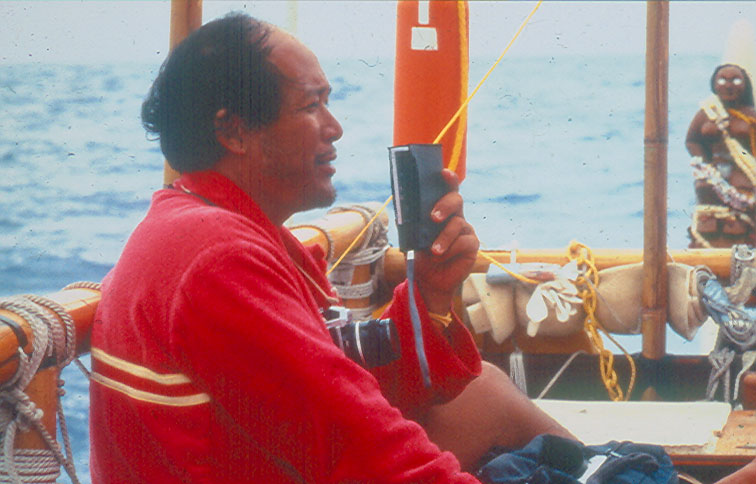
Mike Tongg, 1985
